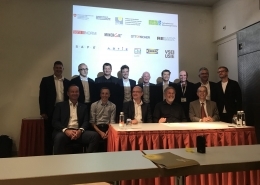Behavioural Insights: Using behavioral insights to reduce energy consumption
How can companies be motivated to increase energy efficiency and reduce CO2 emissions at the same time without imposing regulations? A report commissioned by SwissEnergy shows: In addition to target agreements that companies conclude with the federal government, in which they commit to energy efficiency measures, there are many other options. Concrete projects for SMEs are to show how practical these options are.
Example electricity bill
Does energy consumption change when an SME finds additional information on costs and electricity consumption and recommendations for action on the electricity bill? Centralschweizerische Kraftwerke AG (CKW) is trying to find out this question in a scientifically supported project with its SME customers. The focus is on five sectors: agriculture and forestry, retail, hospitality, real estate and food, beverages, tobacco.
The following data are under discussion:
- Historical comparisons: SMEs will be able to compare their current and past electricity consumption on the bill and will be informed of any increase in consumption, if applicable.
- Social comparison: to enable SMEs to anonymously compare their own electricity consumption with that of other comparable companies in their industry. This creates an understanding of the proportionality of their own consumption and can highlight potential savings opportunities. The challenge here is data protection and matching with relevant comparable companies. Both of these challenges are being closely examined by the project group.
- Highlighting important information: Specific energy efficiency messages will be added to the energy bill or envelope to highlight specific opportunities for action.
- Energy bills are supplemented with short brochures that publicize specific industry-relevant action tips for increasing energy efficiency.
Which idea CKW ultimately implements will be decided in January 2022.
Example Quick Wins
The aim of the Quick Wins project is to offer SME representatives an easy-to-understand overview that shows them energy-saving measures that they can implement simply, quickly, and cost-effectively in their operations. The basis for this project is anonymized data from target agreements. In a target agreement, a potential analysis is used to determine which measures a company can take to save how much CO2 and energy.
Together with act Cleantech Agentur Schweiz, more than 15'000 data were evaluated and validated quantitatively (Which energy efficiency measures are most popular?) and qualitatively (What do the energy consultants find when analyzing the effective savings?). For each participating sector, three particularly relevant measures were identified and subsequently distributed in communication materials to interested parties/participants in the project. They show how potentially large efficiency gains can be realized in operations with small adjustments. Several industry associations support the project in its implementation.
Example of sustainability labels
Companies can identify themselves as energy-friendly with the sustainability label "Companies for the Climate". The project aims to show whether these companies are more willing to implement energy-saving measures after receiving a label. An online survey of 1000 consumers was used to test how such a label is perceived.
Among other things, the following questions were examined:
- Do consumers prefer companies with a sustainability label to those without?
- How should a sustainability label be designed? Is a company's commitment enough or do we need a certified, verifiable label?
Through the impact of labels on company behavior and consumer perception, the aim is to investigate how labels can be used effectively to motivate companies to be more sustainable. The goal here, too: Increasing energy efficiency and the use of sustainable forms of energy.

Torben Emmerling: co-author of the report "Behavioural Insights in Energy Policy.
Torben Emmerling is Managing Director of Affective Advisory, a specialized consultancy that advises public and private organizations on the application of behavioral science insights. He is co-author of the SFOE report "Behavioural Insights in Energy Policy." Energeiaplus wanted to know from him why the measures focus on SMEs.
Energeiaplus: Examples with electricity bills already exist. In the U.S., it has been shown that households change their consumption when they see how much electricity their neighbors use. A household is more manageable than an SME. Employees in the company don't necessarily see what's on the electricity bill. Why are they convinced that such bills definitely lead to greater efficiency?
Torben Emmerling: The industrial and service sectors account for a large share of Swiss electricity consumption and CO2 emissions. On the way to a sustainable Switzerland, we need to actively involve companies. This is the first time that we are targeting SMEs in this way, and it is the only one of its kind in the world.
Many SMEs are already interested in making their energy consumption more effective and thus contributing to sustainable business. At the same time, many managers in our surveys state that they find it difficult to assess their energy consumption in a meaningful way. They simply lack information that helps them classify their own consumption. This is where our project comes in
If I, as an entrepreneur, learn that I consume significantly more energy than in the previous year or in comparison to other companies in my sector and of my size, this can motivate me to take a closer look at the topic of energy efficiency. Whether in households or businesses, in both cases it is interesting for decision-makers to save energy. How we ultimately reach people in businesses is something our project will show for the first time.
How great is the risk that those electricity customers who always consume less than the average will increase their consumption? What has science found out about this?
It is probably unlikely that information about above-average efficiency will motivate entrepreneurs to subsequently act more wastefully. We therefore assess this risk in the corporate context as rather low, but want to investigate it more closely
Studies from the USA show, among other things, that households slightly increase their energy consumption after being informed that their consumption is below average. However, by giving additional endorsing information, this behavior could be counteracted. Positive feedback, for example in the form of a smiling smile, can be enough.
In your report, you also investigated which barriers, motivators and behavioral patterns Swiss companies perceive with regard to energy efficiency and renewable energies. What is the conclusion?
Our brief conclusion is that virtually all companies still have untapped potential. Many different aspects play a facilitating or hindering role in addressing energy efficiency. Although financial aspects receive the fastest and often the most attention, social and environmental responsibility and public perception are also seen as playing a major motivating role. At the same time, lack of awareness, convenient unquestioned routines, and unclear or inaccessible information form significant barriers
These findings underlie our current projects. Among other things, we are investigating how non-financial incentives can be used effectively (label), how information can be made more easily accessible and comparable (electricity bill), and how SMEs can be empowered to identify and implement fast and monetarily meaningful sustainability measures on their own (quick wins).
People like to decide for themselves and not be pushed or even forced. This also applies to decision-makers in companies. So how should tips be designed?
Our approaches are fundamentally based on the principles of voluntariness, personal responsibility and transparency. We do not oblige, push or force anyone - quite the opposite. We try to make the complex world of energy efficiency a little easier and compete with good ideas, helpful information and relevant recommendations for the participation of decision-makers in the sense of a sustainable and successful Switzerland.
There are already many tips on how to save energy or use renewable energies. Why do we need stickers on the electricity bill or a list of the top three measures?
You are absolutely right. There is already a wealth of information available today that we can hardly process. A study from the U.S. estimates that we subconsciously absorb the amount of information in more than 24 daily newspapers per day.
Consequently, the effectiveness of our approach is not to generate even more information, but to make existing information more accessible, and to support decision makers. We are investigating how we can make decisions that affect energy efficiency easier by providing targeted information and assistance at the right time.
During hotel stays, guests can decide whether or not they want to use the towels for one more day. They either leave them hanging or throw them on the floor. I myself have experienced many times that the towels have been changed, even though I have hung them up nicely. It seems that the message did not get through to the staff.
You are referring here to an experience that can be perfectly linked to one of the most famous behavioral science studies. By simply pointing out the behavior of other people in the same context (e.g., reusing towels in the exact same hotel room), I can motivate people to behave in a more sustainable way. We are talking about an easily accessible social norm here. Of course, this ultimately only works if the hotel also involves all employees and everyone is aware of the responsibility for sustainable business.
Why are the three packages of measures mentioned above being implemented first?
With the final report "Behavioural Insights in Energy Policy" we have published comprehensive practice-relevant basics, approaches and measures. Together with the SFOE project team and the implementation partners, we then evaluated and assessed all proposals and selected the current three pilot projects. We hope that further projects will follow in the coming months and years and that more practical partners will become enthusiastic about implementing them.
Finally, are there any figures on what can be gained in terms of energy efficiency with such measures?
This is an exciting question to which we hope to have a more comprehensive answer soon. As I mentioned, we are breaking new ground with these projects in Switzerland and in some cases even worldwide. In the case of energy bills, if we take the effects of studies with households as a guide, a reduction in electricity consumption of 2 to 4% would potentially be conceivable. This sounds like little at first, but in the context of thousands of companies, current energy prices and Swiss CO2 reduction targets, it is a huge effect with minimal resources. So we can be very curious.
Brigitte Mader, Communication, Swiss Federal Office of Energy
 keystone-sda
keystone-sda
 Velo-Mittwoch: Wer Velo fährt, kann nur gewinnen!
Velo-Mittwoch: Wer Velo fährt, kann nur gewinnen!  die Schweizerische PostErfolgsprojekt Baulogistik Hub
die Schweizerische PostErfolgsprojekt Baulogistik Hub  BFELichtbranche will Stromverbrauch für Beleuchtung bis 2025 halbieren
BFELichtbranche will Stromverbrauch für Beleuchtung bis 2025 halbieren  Neue Gesamtdokumentation Kleinwasserkraft
Neue Gesamtdokumentation Kleinwasserkraft 
 Swisscom
Swisscom © Fluxif (Gerry Nitsch) / Das Gebäudeprogramm
© Fluxif (Gerry Nitsch) / Das Gebäudeprogramm
Dein Kommentar
An Diskussion beteiligen?Hinterlassen Sie uns Ihren Kommentar!